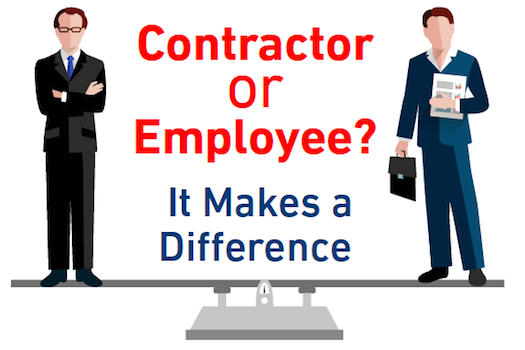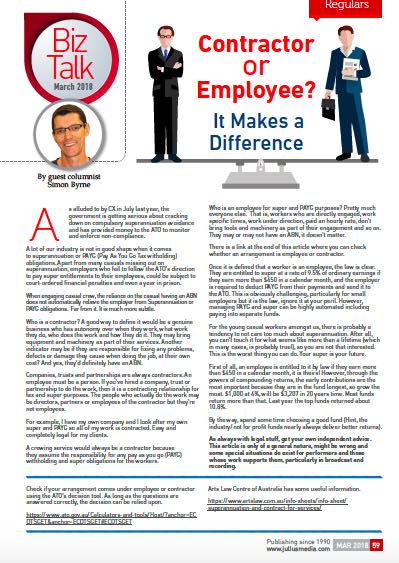News
28 Mar 2018
Biz Talk: Contractor or Employee? It Makes a Difference

Subscribe to CX E-News
REGULARS
Biz Talk: Contractor or Employee? It Makes a Difference
 By guest columnist Simon Byrne.
By guest columnist Simon Byrne.
As alluded to by CX Magazine in July last year, the government is getting serious about cracking down on compulsory superannuation avoidance and has provided money to the ATO to monitor and enforce non-compliance.
A lot of our industry is not in good shape when it comes to superannuation or PAYG (Pay As You Go Tax witholding) obligations.
Apart from many casuals missing out on superannuation, employers who fail to follow the ATO’s direction to pay super entitlements to their employees, could be subject to court-ordered financial penalties and even a year in prison.
When engaging casual crew, the reliance on the casual having an ABN does not automatically relieve the employer from Superannuation or PAYG obligations. Far from it.
It is much more subtle.
Who is a contractor? A good way to define it would be a genuine business who has autonomy over when they work, what work they do, who does the work and how they do it. They may bring equipment and machinery as part of their services.
Another indicator may be if they are responsible for fixing any problems, defects or damage they cause when doing the job, at their own cost? And yes, they’d definitely have an ABN.
Companies, trusts and partnerships are always contractors. An employee must be a person.
If you’ve hired a company, trust or partnership to do the work, then it is a contracting relationship for tax and super purposes. The people who actually do the work may be directors, partners or employees of the contractor but they’re not employees.
For example, I have my own company and I look after my own super and PAYG so all of my work is contracted. Easy and completely legal for my clients.A crewing service would always be a contractor because they assume the responsibility for any pay as you go (PAYG) withholding and super obligations for the workers.
Who is an employee for super and PAYG purposes? Pretty much everyone else. That is, workers who are directly engaged, work specific times, work under direction, paid an hourly rate, don’t bring tools and machinery as part of their engagement and so on. They may or may not have an ABN, it doesn’t matter.
There is a link at the end of this article where you can check whether an arrangement is employee or contractor.
Once it is defined that a worker is an employee, the law is clear. They are entitled to super at a rate of 9.5% of ordinary earnings if they earn more than $450 in a calendar month, and the employer is required to deduct PAYG from their payments and send it to the ATO.
This is obviously challenging, particularly for small employers but it is the law, ignore it at your peril. However, managing PAYG and super can be highly automated including paying into separate funds.
For the young casual workers amongst us, there is probably a tendency to not care too much about superannuation. After all, you can’t touch it for what seems like more than a lifetime (which in many cases, is probably true!), so you are not that interested. This is the worst thing you can do. Your super is your future.
First of all, an employee is entitled to it by law if they earn more than $450 in a calendar month, it is theirs! However, through the powers of compounding returns, the early contributions are the most important because they are in the fund longest, so grow the most. $1,000 at 6%, will be $3,207 in 20 years time. Most funds return more than that. Last year the top funds returned about 10.8%.
By the way, spend some time choosing a good fund (Hint, the industry/not for profit funds nearly always deliver better returns).
As always with legal stuff, get your own independent advice. This article is only of a general nature, might be wrong and some special situations do exist for performers and those whose work supports them, particularly in broadcast and recording.
Further information:
Check if your arrangement comes under employee or contractor using the ATO’s decision tool. As long as the questions are answered correctly, the decision can be relied upon:
> Employee/contractor Decision Tool
Arts Law Centre of Australia has some useful information:
> Arts Law Information Sheet: Superannuation and contract for services
This article first appeared in the print edition of CX Magazine March 2018, p.59. CX Magazine is Australia and New Zealand’s only publication dedicated to entertainment technology news and issues. Read all editions for free or search our archive www.cxnetwork.com.au
Related reading from Juliusmedia:
Employee or Contractor: Are YOU Sham Contracting?
Push out the Cowboys. Why we need ACCREDITATION
Paying for Contractor Compliance
Subscribe
Published monthly since 1991, our famous AV industry magazine is free for download or pay for print. Subscribers also receive CX News, our free weekly email with the latest industry news and jobs.





